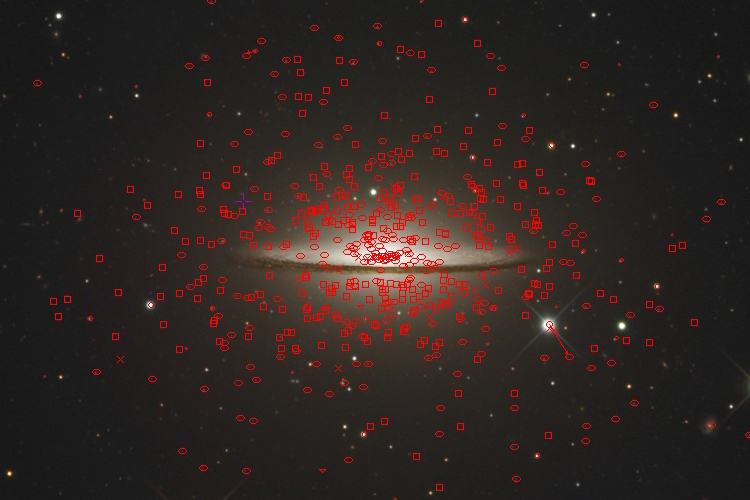|
|

| In the above
image, ellipses are globular clusters, squares are planetary nebulae
and circles are stars. The SIMBAD database identifies 200 globular
clusters in the upper image. There are magnitude data for 93, with the
blue magnitude ranging from 18 to 22.6. The faintest visible
cluster, in the top image, is at magnitude 22.04... ranking 85th of
the 93. None of the planetary nebulae are identified in the image.
|
|
Instrument |
12.5" RCOS @
~f/9 (2880 mm fl) 0.64 arcsec / pixel. Zoomify image scale is
0.64 to 1.79 arcsec / pixel. |
|
Mount |
Paramount ME |
|
Camera |
SBIG STL-11000 w/ internal filter wheel, AstroDon Gen I Filters |
|
Acquisition Data |
4/14/2010 to 5/15/2010
Chino Valley, AZ... with CCDAutoPilot3 & CCDSoft, AOL guided
@ 1.1 Hz. |
|
Exposure |
Lum (no filter)
330 min (22 x 15 min, bin 1x1)
RGB
225 min ( 5 x 15 min each, bin 2x2) |
|
Software |
-
CCDSoft, CCDStack,
Photoshop CS w/ the Fits Liberator plugin. Noel Carboni's actions
and Russell Croman's GradientXTerminator.
-
eXcalibrator for (u-g), (g-r) color calibration, using 8 stars from
the SDSS-7 database.
-
PixFix32 (pre-beta) to
repair hot/cold pixels and column defects.
-
CCDStack to calibrate,
register, normalize, data reject, combine the sub exposures, LRGB
color, and luminance deconvolution.
-
PhotoShop for LLRGB
combine &
on-linear stretching.
|
|
Comment |
North is to top.
The Sombrero Galaxy
was discovered in March of 1767 by Pierre Méchain. At a distance of
60 million light-years, the unbarred galaxy is locate in the
constellation Virgo. Glowing brightly, at magnitude 9.1, M104 is an
easy visual target for small backyard telescopes.
M104 features a prominent dust lane and a bright halo of stars and
globular clusters. The galaxy has a relatively large number of
globular clusters. Observational studies estimate a population of
1200 to 2000. Our galaxy only has about 160 globular clusters.
|
|